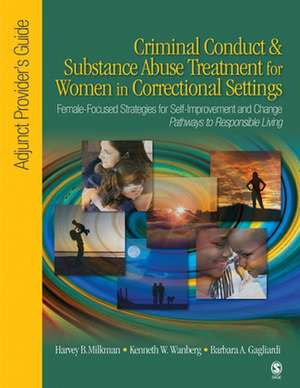Criminal Conduct and Substance Abuse Treatment for Women in Correctional Settings: Adjunct Provider's Guide: Female-Focused Strategies for Self-Improvement and Change-Pathways to Responsible Living
Autor Harvey B. Milkman, Kenneth W. Wanberg, Barbara A. Gagliardien Limba Engleză Paperback – 2 iun 2009
Preț: 481.87 lei
Nou
92.23€ • 99.55$ • 77.33£
Carte tipărită la comandă
Livrare economică 18 aprilie-02 mai
Specificații
ISBN-10: 1412905931
Pagini: 256
Dimensiuni: 216 x 279 x 15 mm
Greutate: 0.59 kg
Ediția:1
Editura: SAGE Publications
Colecția Sage Publications, Inc
Locul publicării:Thousand Oaks, United States
Cuprins
Introduction
SECTION I: UNDERSTANDING THE CAUSES AND CONTEXT OF FEMALE SUBSTANCE ABUSE, CRIME, AND MENTAL DISORDER
1. Women and Crime
Scope of the Problem: Women in the Criminal Justice System
General Patterns of Criminal Conduct Among Women
Risk Factors and Dynamic Predictors of Criminal Condut in Women
Theories of Female Crime
Implications for Treatment and Policy: What Factors Reduce Recidivism Among Female Judicial Clients?
Chapter Review
2. Connecting Female Substance Abuse, Cognition, and Crime
Gender Differences in Substance Abuse
Psychosocial Issues and Substance Abuse in Women
Patterns and Trends in Women's Lives
Stigmas and Stereotypes of Women and Substance Abuse
The Interaction of Women's Social Roles and Relationships
Gender Norms and Sense of Self
Personal Responsibility and the Sociocentric Perspective
Implications for Treatment and Policy: What Factors Reduce Recidivism?
Chapter Review
3. Mental and Physical Health Issues in Female Criminal Justice Clients
Overview of Mental Health Issues in Female Substance-Abusing Judicial Clients
Dual Diagnosis in Women: Common Psychiatric Disorders Found Among Women Judicial Clients
Women and Violent Trauma
The Specific Causes of Violent Trauma
Medical Challenges for Women Judical Clients
Ethnic Considerations in Health Care
Implications for Treatment and Policy: What Factors Reduce Recidivism?
Chapter Review
4. Adolescent Girls and Delinquency: The Route Into Correctional Settings
Gender Differences Between Adolescents in AOD Treatment and Juvenile Justice Settings
Adolescent Girls and Delinquency
The Nature of Female Adolescent Offense
Juvenile Victims of Crime
Risk Factors for Juvenile Offending Among Females
Psychological Consequences of Violent Trauma in Adolescence
Gender Norms and Adolescence
Girls and Gangs
Female Adolescent Detention
Experiences of Girls Within the Juvenile Justice System
Implications for Treatment and Policy: What Factors Reduce Recidivism?
Chapter Review
5. Understanding Posttraumatic Stress Disorder
History of Posttraumatic Stress Disorder
PTSD Population Statistics
Symptoms of Posttraumatic Stress Disorder
Complex Posttraumatic Stress Disorder
PTSD Assessment Methods
Posttraumatic Stress Disorder and Gender
Posttraumatic Stress Disorder and Childhood Trauma
Posttraumatic Stress Disorder and the Female Judicial Client
Allostasis and the Allostatice Load Factor
Recovery From Trauma
Core Areas and Treatment Goals for Posttraumatic Stress Disorder
Treatment Modalities
Therapist Characteristics
Chapter Review
SECTION II: ESSENTIAL ELEMENTS IN THE EDUCATION AND TREATMENT OF FEMALE JUDICIAL CLIENTS
6. Assessment of Women in Correctional Settings
Overview of the SSC Assessment Program
Components of Assessment
An Assessment and Case Management Service Planning Model
Specific Factors Important in the Assessment of Female Judicial Clients
The Client Master Profile and Master Assessment Plan
Treatment Matching
Collaborative Involvement in Assessment and the Development of the Treatment Plan
The Continuum of Care
Chapter Review
7. Gender as Culture and Other Diversity Considerations
Diversity Considerations in Working with Women Judicial Clients
Beyond Cultural Differences
Socioeconomic Issues
Women Judicial Clients and Their Children
Chapter Review
8. Gender-Specific Strategies and Models for Treatment
The Therapeutic Alliance: What Makes an Effective Counselor?
The Therapeautic Environment
Goals of Treatment With Female Judicial Clients
Therapeutic Intervention With Female Judicial Clients
Individualized Plans for Reentry and Transition
Support for Service Providers
Current Trends in Women-Focused Programs: Models for Treatment
Chapter Review
SECTION III: GENDER-SPECIFIC ADAPTATIONS FOR WOMEN
PHASE I: Challenge to Change
Module 1: Orientation: How This Program Works
Module 2: Cognitive-Behavioral Approach to Change and Responsible Living
Module 3: AOD Use Patterns and Outcomes
Module 4: Understanding Criminal Thinking and Behavior
Module 5: Sharing and Listening: Communication Pathways to Self-Awareness and Other-Awareness
Module 6: Understanding and Preventing Relapse and Recidivism
Module 7: The Process and Skills for Self-Improvement and Change
PHASE II: Commitment to Change
Module 8: Self-Control: Managing Thoughts and Emotions
Module 9: Social and Relationship Skills Building
Module 10: Skills in Social and Community Responsibility
PHASE III: Ownership of Change: Lifestyle Balance and Healthy Living
Module 11: Relapse and Recidivism Prevention: Review Strategies for Healthy Living
Module 12: Strengthening Ownership of Change: Skills for a Healthy Lifestyle
PROGRAM CLOSURE: Continuing Your Journey of Responsible Living
Notă biografică
Harvey B. Milkman, PhD received his baccalaureate degree from City College of New York and his doctorate from Michigan State University. He is currently professor of psychology at Metropolitan State College of Denver. His doctoral research was conducted with William Frosch, MD, at Bellevue Psychiatric Hospital in New York City, on the User¿s Drug of Choice. From 1980¿1981, he completed a sabbatical exploration of addictive behavior in Africa, India, and Southeast Asia; in 1985 he was recipient of a Fulbright-Hays Lectureship award at the National University of Malaysia. He has represented the United States Information Agency as a consultant and featured speaker in Australia, Brazil, Iceland, The Netherlands, Peru, Turkey, and Yugoslavia. He is principle author with Stanley Sunderwirth of ¿The Chemistry of Craving,¿ and author of ¿Better than Dope,¿ featured articles in Psychology Today, October, 1983 and April, 2001 respectively. From September 1992¿June 2002, he was author, principal investigator, and director of Project Self-Discovery: Artistic Alternatives for High-Risk Youth, a national demonstration model funded by The Center for Substance Abuse Prevention and the Edward Byrne Foundation.










